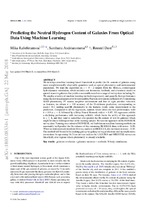| dc.description.abstract | We develop a machine learning-based framework to predict the Hi content of galaxies using
more straightforwardly observable quantities such as optical photometry and environmental
parameters. We train the algorithm on z = 0 - 2 outputs from the Mufasa cosmological
hydrodynamic simulation, which includes star formation, feedback, and a heuristic model to
quench massive galaxies that yields a reasonable match to a range of survey data including Hi.
We employ a variety of machine learning methods (regressors), and quantify their performance
using the root mean square error (rmse) and the Pearson correlation coefficient (r). Considering
SDSS photometry, 3rd nearest neighbor environment and line of sight peculiar velocities
as features, we obtain r > 0:8 accuracy of the Hi-richness prediction, corresponding to
rmse< 0:3. Adding near-IR photometry to the features yields some improvement to the
prediction. Compared to all the regressors, random forest shows the best performance, with
r > 0:9 at z = 0, followed by a Deep Neural Network with r > 0:85. All regressors exhibit
a declining performance with increasing redshift, which limits the utility of this approach
to z ~<1, and they tend to somewhat over-predict the Hi content of low-Hi galaxies which
might be due to Eddington bias in the training sample.We test our approach on the RESOLVE
survey data. Training on a subset of RESOLVE, we find that our machine learning method can
reasonably well predict the Hi-richness of the remaining RESOLVE data, with rmse~ 0:28.
Whenwe train on mock data fromMufasa and test onRESOLVE, this increases to rmse~ 0:45.
Our method will be useful for making galaxy-by-galaxy survey predictions and incompleteness
corrections for upcoming Hi 21cm surveys such as the LADUMA and MIGHTEE surveys on
MeerKAT, over regions where photometry is already available. | en_US |

